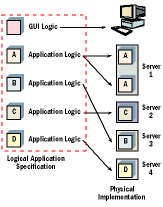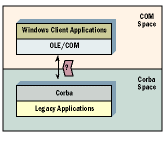
Why Partition? A discussion of why multitier apps may be preferable; a guide to when it makes sense, when it may not.

Object Management Group's Corba services find way into products, easing the I/S task of building distributed applications.
Pervasive computing refers to a generation of technology that will integrate smart things that link with the computing infrastructure. The post-PC era will bring devices that won't bother us until we're asked to be involved in their operation. The Java language, its associated class libraries, and virtual machine technology are the keystones to making the pervasive world possible.

The primary objective of this article is to demonstrate to readers how their design and code can evolve to use a pattern. The goal of this evolution is the Observer pattern.
Reflection is a powerful and intriguing feature of Java. Using the facilities of the class <FONT FACE="Courier">java.lang.Class</FONT> and the Reflection API (<FONT FACE="Courier">package java.lang.reflect</FONT>), programmers can gather information about classes in the JVM at runtime, including references to methods and constructors. After obtaining these references in the form of <FONT FACE="Courier">Method</FONT> and <FONT FACE="Courier">Constructor</FONT> objects, users can invoke them with parameters (via the <FONT FACE="Courier">invoke()</FONT> method of <FONT FACE="Courier">Method</FONT> and the <FONT FACE="Courier">newInstance()</FONT> method of <FONT FACE="Courier">Constructor</FONT>) and manipulate the results.<P>
The addition of reflection to the Java API has enabled such potent technologies as JavaBeans, serialization, RMI, and dynamic proxies. However, reflection has limitations that might surprise users. The purpose of this article is to share these limitations with readers, and to offer a solution for dealing with them.

Strong showing of DCOM and viability of Corba leave corporate developers with the daunting task of integrating two technologies.